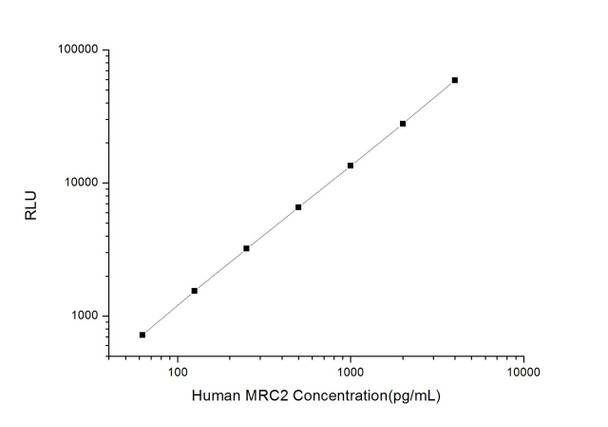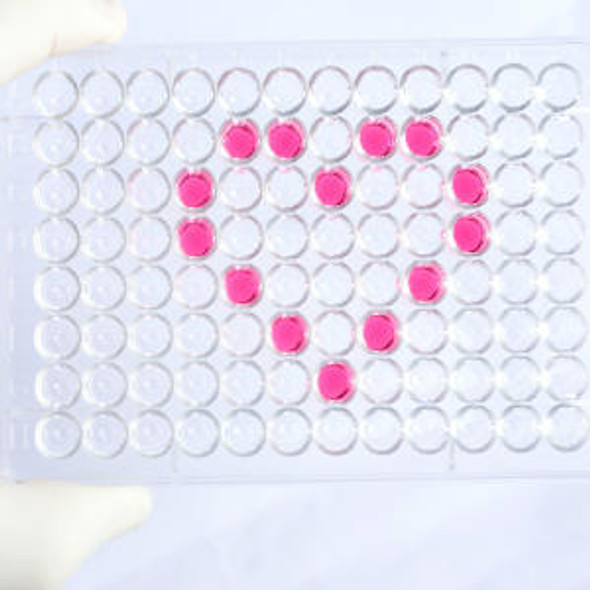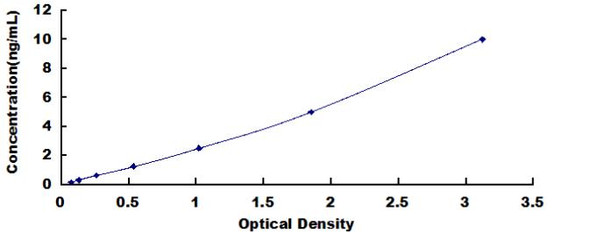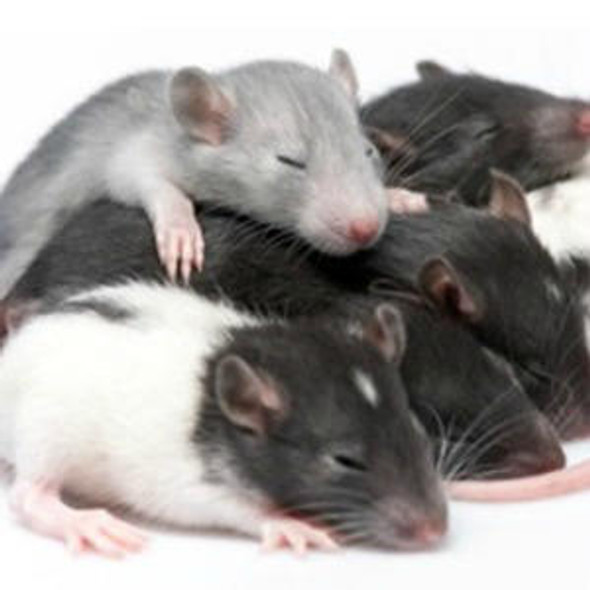Human Cell Biology ELISA Kits 5
Human MRC2 (Mannose Receptor C Type 2) CLIA Kit (HUES01238)
- SKU:
- HUES01238
- Product Type:
- ELISA Kit
- ELISA Type:
- CLIA Kit
- Size:
- 96 Assays
- Sensitivity:
- 37.5pg/mL
- Range:
- 62.5-4000pg/mL
- ELISA Type:
- Sandwich
- Reactivity:
- Human
- Sample Type:
- Serum, plasma and other biological fluids
- Research Area:
- Cell Biology
Description
| Assay type: | Sandwich |
| Format: | 96T |
| Assay time: | 4.5h |
| Reactivity: | Human |
| Detection method: | Chemiluminescence |
| Detection range: | 62.50-4000 pg/mL |
| Sensitivity: | 37.50 pg/mL |
| Sample volume: | 100µL |
| Sample type: | Serum, plasma and other biological fluids |
| Repeatability: | CV < 15% |
| Specificity: | This kit recognizes Human MRC2 in samples. No significant cross-reactivity or interference between Human MRC2 and analogues was observed. |
This kit uses Sandwich-CLIA as the method. The micro CLIA plate provided in this kit has been pre-coated with an antibody specific to Human MRC2. Standards or samples are added to the appropriate micro CLIA plate wells and combined with the specific antibody. Then a biotinylated detection antibody specific for Human MRC2 and Avidin-Horseradish Peroxidase (HRP) conjugate are added to each micro plate well successively and incubated. Free components are washed away. The substrate solution is added to each well. Only those wells that contain Human MRC2, biotinylated detection antibody and Avidin-HRP conjugate will appear fluorescence. The Relative light unit (RLU) value is measured spectrophotometrically by the Chemiluminescence immunoassay analyzer. The RLU value is positively associated with the concentration of Human MRC2. The concentration of Human MRC2 in the samples can be calculated by comparing the RLU of the samples to the standard curve.
| UniProt Protein Function: | MRC2: May play a role as endocytotic lectin receptor displaying calcium-dependent lectin activity. Internalizes glycosylated ligands from the extracellular space for release in an endosomal compartment via clathrin-mediated endocytosis. May be involved in plasminogen activation system controlling the extracellular level of PLAUR/PLAU, and thus may regulate protease activity at the cell surface. May contribute to cellular uptake, remodeling and degradation of extracellular collagen matrices. May play a role during cancer progression as well as in other chronic tissue destructive diseases acting on collagen turnover. May participate in remodeling of extracellular matrix co-operating with the matrix metalloproteinases (MMPs). |
| UniProt Protein Details: | Protein type:Membrane protein, integral Chromosomal Location of Human Ortholog: 17q23. 2 Cellular Component: focal adhesion; membrane Molecular Function:collagen binding; protein binding Biological Process: collagen catabolic process; osteoblast differentiation |
| NCBI Summary: | This gene encodes a member of the mannose receptor family of proteins that contain a fibronectin type II domain and multiple C-type lectin-like domains. The encoded protein plays a role in extracellular matrix remodeling by mediating the internalization and lysosomal degradation of collagen ligands. Expression of this gene may play a role in the tumorigenesis and metastasis of several malignancies including breast cancer, gliomas and metastatic bone disease. [provided by RefSeq, Feb 2012] |
| UniProt Code: | Q9UBG0 |
| NCBI GenInfo Identifier: | 317373394 |
| NCBI Gene ID: | 9902 |
| NCBI Accession: | Q9UBG0. 2 |
| UniProt Secondary Accession: | Q9UBG0,Q7LGE7, Q9Y5P9, A6H8K4, D3DU08, |
| UniProt Related Accession: | Q9UBG0 |
| Molecular Weight: | 166,674 Da |
| NCBI Full Name: | C-type mannose receptor 2 |
| NCBI Synonym Full Names: | mannose receptor C type 2 |
| NCBI Official Symbol: | MRC2 |
| NCBI Official Synonym Symbols: | CD280; UPARAP; CLEC13E; ENDO180 |
| NCBI Protein Information: | C-type mannose receptor 2 |
| UniProt Protein Name: | C-type mannose receptor 2 |
| UniProt Synonym Protein Names: | C-type lectin domain family 13 member E; Endocytic receptor 180; Macrophage mannose receptor 2; Urokinase-type plasminogen activator receptor-associated protein; UPAR-associated protein; Urokinase receptor-associated protein; CD_antigen: CD280 |
| Protein Family: | C-type mannose receptor |
| UniProt Gene Name: | MRC2 |
| UniProt Entry Name: | MRC2_HUMAN |
As the RLU values of the standard curve may vary according to the conditions of the actual assay performance (e. g. operator, pipetting technique, washing technique or temperature effects), the operator should establish a standard curve for each test. Typical standard curve and data is provided below for reference only.
| Concentration (pg/mL) | RLU | Average | Corrected |
| 4000 | 55981 62181 | 59081 | 59046 |
| 2000 | 26662 29056 | 27859 | 27824 |
| 1000 | 14156 12812 | 13484 | 13449 |
| 500 | 6287 6923 | 6605 | 6570 |
| 250 | 3439 3047 | 3243 | 3208 |
| 125 | 1688 1474 | 1581 | 1546 |
| 62.50 | 740 770 | 755 | 720 |
| 0 | 34 36 | 35 | -- |
Precision
Intra-assay Precision (Precision within an assay): 3 samples with low, mid range and high level Human MRC2 were tested 20 times on one plate, respectively.
Inter-assay Precision (Precision between assays): 3 samples with low, mid range and high level Human MRC2 were tested on 3 different plates, 20 replicates in each plate.
| Intra-assay Precision | Inter-assay Precision | |||||
| Sample | 1 | 2 | 3 | 1 | 2 | 3 |
| n | 20 | 20 | 20 | 20 | 20 | 20 |
| Mean (pg/mL) | 207.98 | 480.52 | 1431.39 | 212.36 | 457.99 | 1359.01 |
| Standard deviation | 24.56 | 44.83 | 113.37 | 22.28 | 40.72 | 130.33 |
| C V (%) | 11.81 | 9.33 | 7.92 | 10.49 | 8.89 | 9.59 |
Recovery
The recovery of Human MRC2 spiked at three different levels in samples throughout the range of the assay was evaluated in various matrices.
| Sample Type | Range (%) | Average Recovery (%) |
| Serum (n=5) | 93-105 | 99 |
| EDTA plasma (n=5) | 87-100 | 94 |
| Cell culture media (n=5) | 90-104 | 97 |
Linearity
Samples were spiked with high concentrations of Human MRC2 and diluted with Reference Standard & Sample Diluent to produce samples with values within the range of the assay.
| Serum (n=5) | EDTA plasma (n=5) | Cell culture media (n=5) | ||
| 1:2 | Range (%) | 95-107 | 86-102 | 94-108 |
| Average (%) | 101 | 93 | 102 | |
| 1:4 | Range (%) | 94-107 | 102-115 | 95-109 |
| Average (%) | 102 | 108 | 101 | |
| 1:8 | Range (%) | 85-96 | 92-104 | 91-103 |
| Average (%) | 91 | 99 | 97 | |
| 1:16 | Range (%) | 88-99 | 89-102 | 84-99 |
| Average (%) | 94 | 96 | 91 |
An unopened kit can be stored at 4°C for 1 month. If the kit is not used within 1 month, store the items separately according to the following conditions once the kit is received.
| Item | Specifications | Storage |
| Micro CLIA Plate(Dismountable) | 8 wells ×12 strips | -20°C, 6 months |
| Reference Standard | 2 vials | |
| Concentrated Biotinylated Detection Ab (100×) | 1 vial, 120 µL | |
| Concentrated HRP Conjugate (100×) | 1 vial, 120 µL | -20°C(shading light), 6 months |
| Reference Standard & Sample Diluent | 1 vial, 20 mL | 4°C, 6 months |
| Biotinylated Detection Ab Diluent | 1 vial, 14 mL | |
| HRP Conjugate Diluent | 1 vial, 14 mL | |
| Concentrated Wash Buffer (25×) | 1 vial, 30 mL | |
| Substrate Reagent A | 1 vial, 5 mL | 4°C (shading light) |
| Substrate Reagent B | 1 vial, 5 mL | 4°C (shading light) |
| Plate Sealer | 5 pieces | |
| Product Description | 1 copy | |
| Certificate of Analysis | 1 copy |
- Set standard, test sample and control (zero) wells on the pre-coated plate and record theirpositions. It is recommended to measure each standard and sample in duplicate. Note: addall solutions to the bottom of the plate wells while avoiding contact with the well walls. Ensuresolutions do not foam when adding to the wells.
- Aliquot 100 µL of standard solutions into the standard wells.
- Add 100 µL of Sample / Standard dilution buffer into the control (zero) well.
- Add 100 µL of properly diluted sample (serum, plasma, tissue homogenates and otherbiological fluids. ) into test sample wells.
- Cover the plate with the sealer provided in the kit and incubate for 90 min at 37 °C.
- Aspirate the liquid from each well, do not wash. Immediately add 100 µL of BiotinylatedDetection Ab working solution to each well. Cover the plate with a plate seal and gently mix. Incubate for 1 hour at 37 °C.
- Aspirate or decant the solution from the plate and add 350 µL of wash buffer to each welland incubate for 1-2 minutes at room temperature. Aspirate the solution from each well andclap the plate on absorbent filter paper to dry. Repeat this process 3 times. Note: a microplatewasher can be used in this step and other wash steps.
- Add 100 µL of HRP Conjugate working solution to each well. Cover with a plate seal andincubate for 30 min at 37 °C.
- Aspirate or decant the solution from each well. Repeat the wash process for five times asconducted in step 7.
- Add 100 µL of Substrate mixture solution to each well. Cover with a new plate seal andincubate for no more than 5 min at 37 °C. Protect the plate from light.
- Determine the RLU value of each well immediately.






